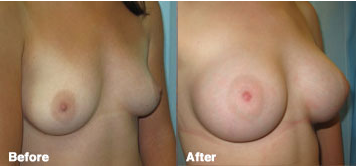Choosing to change the way you look through cosmetic surgery is probably one of the most important decisions you will make.
Why and when is a breast enlargement performed?
Many women find that the size and shape of their breasts affects their self-confidence. If you feel that your breasts are out of proportion with the rest of your body, or that age or breastfeeding have caused them to shrink or lose their shape, a breast enlargement operation (also known as breast augmentation or having breast implants) can help.

What can you expect?
Breast implants are used to make your breasts larger, firmer and fuller. Breast implants are available in a variety of types and sizes and their shape is either “round” in profile and base, or oval shaped with an anatomical contour. They are usually made of an outer layer of silicone, filled with cohesive silicone gel. This is a soft gel which is highly elastic with the approximate specific gravity and feel of normal breast fat. Silicone materials have “memory” ie the shell and gel components of an implant can be stretched and they will return to their normal state when relaxed.
You’ll be able to see different examples of breast implant and discuss the advantages and disadvantages of each before you decide which one is best for you. There are different techniques available which result in different scars either under the breast, around the nipple or in the armpit.
You will be given a further consultation in two weeks, at no additional cost to you, to discuss any queries you may have following your initial consultation. You can bring along your partner, parent or friend for any of these consultations.
You will have to undergo an examination and may have some simple health checks such as blood tests and in some cases a mammogram. If you decide on surgery you will be required to sign a consent form giving permission for the operation. This requires that you are aware of the risks and complications involved with the procedure, which will have been explained to you.
What is involved in the operation?
Breast enlargement surgery will be performed under a general anaesthetic, usually takes about an hour and in many cases is performed as a day case without the need for an overnight stay in hospital. The surgery involves placement of an implant either under the skin and breast tissue or deeper under the muscle under the breast. There are many different types and sizes of implant available. They all have a silicone outer layer but may be filled with silicone (cohesive gel that doesn’t run if cut.


Post-Operative Parient Care Information:
What are the complications for this procedure?
The insertion of breast implants either for breast re construction or for cosmetic purposes presents the same health risks common to any surgery, such as adverse reaction to anaesthesia, haematoma (post-operative bleeding), DVT and infection. Complications specific to breast augmentation include scarring and reduced sensation; capsule formation and rupture of the implant.
When not to have this procedure?
Patients who are actively smoking or on blood thinning medication such as aspirin or warfarin have a higher risk for postoperative complications such as bleeding, wound infections and delayed wound healing. It is advisable not to consume nicotine in any form for at least two weeks before this procedure and at least two to three weeks after. Medication such as aspirin or warfarin may need to be stopped if they are not absolutely essential at the appropriate time before surgery. This should be discussed with your Consultant or GP.
FACTS AT A GLANCE
| Surgery time | 1 hour |
| Hospital stay | Day case or 1 night |
| Anaesthetic assessment | No |
| Pre admission tests | Yes |
| Sleeping position | Sleeping on back recommended for 4 weeks. |
| Reasonably mobile | 1 day |
| Washing | Shower after 1 day. Bath only after 2 weeks. |
| Driving | 3 weeks |
| Exercise including gym | 8 weeks |
| Full recovery | 6-8 weeks |
| Time off work | 2 weeks |
| Bras and garments | Fitted bra worn for 1 week. Sports bra worn for further 2 weeks. Wired bra only after 2 months |
| Long term issues | Risk of capsulation. |
Update on ALCL
Anaplastic large cell lymphoma (ALCL) is a rare type of non-Hodgkin’s lymphoma (NHL), a cancer involving the cells of the immune system. It accounts for less than 1% of all breast malignancies.
In January 2011 the FDA published a Safety Communication entitled ‘FDA Medical Device Safety Communication: Reports of Anaplastic Large Cell Lymphoma (ALCL) in Women with Breast Implants’.
In a review by the FDA of scientific literature published from January 1997 to May 2010, they identified 34 cases of ALCL in women with breast implants worldwide. The FDA’s adverse event reporting system also contained 17 reports of ALCL in women with breast implants.
In May 2014 the final report on PIP silicone breast implants was published by the European Commission and its non-food Scientific Committee on Emerging and Newly Identified Health Risks (SCENIHR) which identified 130 case reports worldwide of patients with all types of breast implants who had developed ALCL. This is a very small proportion of the 5-10 million women who have received breast implants worldwide.
The MHRA will analyse any further reports in order to build a fuller picture of the occurrence of this rare disease in association with breast implants.
